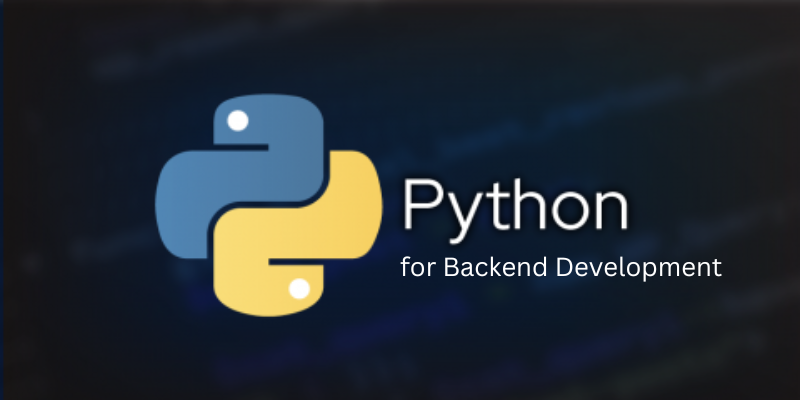Python is widely favored for backend development due to its versatility and ease of use. Its rich ecosystem of frameworks and libraries, combined with strong community support, makes it ideal for building scalable and efficient backends. Python’s simplicity promotes rapid development, while its powerful features ensure robust data handling and security. This blend of advantages positions Python as a go-to language for modern backend solutions. This blog explore the benefits of python for backend development. Join the Python Course in Ahmedabad, which offers hands-on experience and job placement support.
Scalability and Flexibility in Backend Development
Python provides scalability and flexibility, making it an excellent choice for backend development. Its versatility allows developers to build both simple and complex applications. Python’s dynamic typing and interpreted nature enable developers to modify the backend efficiently without significantly impacting the overall system. This makes it adaptable for projects of various sizes, ensuring that the backend can evolve as the application grows.
Diverse Set of Frameworks and Libraries
Python boasts a diverse ecosystem of frameworks and libraries that significantly improve backend development. Frameworks like Django, Flask, and Pyramid simplify building robust and scalable backends by providing pre-built components for tasks like database connections, authentication, and routing. Libraries such as SQLAlchemy for database management or Requests for handling HTTP requests streamline backend operations. This extensive support reduces development time and allows developers tofoc concentrate on the core functionality of the application.
Easy Integration with Other Technologies
Python’s compatibility with various technologies and languages makes it an ideal candidate for backend integration. It can seamlessly integrate with web services, databases, and frontend technologies, allowing for smooth communication between different parts of an application. Python’s ability to work well with RESTful APIs and support for popular databases like MySQL, PostgreSQL, and MongoDB makes it highly effective in backend development, ensuring cohesive and efficient data handling. To gain insights into the current trends in Python development, join the Python Course in Gurgaon.
High Readability and Maintainability
Python’s clean and easy-to-understand syntax enhances code readability, which is a critical factor in backend development. Clear code ensures that development teams can work together more efficiently, decreasing the chance of errors and simplifying maintenance and updates backend systems over time. The readability of Python also promotes quicker onboarding of new developers, allowing teams to scale more easily without significant knowledge transfer hurdles.
Strong Community Support
Python boasts a vast and active developer community, offering extensive support and resources for backend development. The community contributes regularly to Python’s extensive documentation, providing tutorials, guides, and troubleshooting tips. This support is beneficial for developers facing backend challenges, as they can easily find solutions, share knowledge, and leverage community-contributed libraries to address common backend issues efficiently.
Efficient Handling of Data and API Requests
Python excels in handling data-intensive backend tasks. Its libraries, such as Pandas and NumPy, allow developers to process and manage large volumes of data with ease. For web applications that rely heavily on APIs, Python’s simplicity in handling API requests and its ability to parse and manipulate data make it a strong contender for backend operations. This efficiency is especially valuable in applications requiring real-time data processing and analysis.
Asynchronous Programming Capabilities
Python’s asynchronous programming support, particularly with frameworks like Asyncio, enhances its performance in backend development. Asynchronous programming allows Python applications to handle multiple tasks concurrently, improving the responsiveness and performance of web applications. This is especially beneficial in handling large numbers of requests or managing long-running processes, where Python can optimize resource usage and reduce server load. Explore Python Course in Kolkata to thoroughly understand OOP concepts in Python.
Security Features in Python
Python’s built-in security features make it a strong choice for backend development in applications where data security is crucial. Frameworks like Django include built-in protection against common security threats, such as SQL injection, cross-site scripting (XSS), and cross-site request forgery (CSRF). Python’s community also regularly updates security patches, ensuring that backend systems remain secure and compliant with industry standards.
Efficient Prototyping and Fast Development Cycles
Python’s simplicity and ease of use contribute to faster development cycles, which is especially valuable in backend development. Developers can quickly prototype and test backend functionalities, iterating efficiently to meet project deadlines. Python’s ability to handle both quick prototyping and production-level backend development makes it suitable for startups and large-scale enterprises alike, allowing them to bring products to market faster.
Cross-Platform Compatibility
Python’s cross-platform nature means that backend systems developed using Python can run on different operating systems, such as Linux, macOS, and Windows, without modification. This compatibility is essential for backend systems that need to function across various environments, ensuring flexibility and ease of deployment. Python’s portability also reduces the risk of platform-specific issues, making backend development more efficient and reliable. Enrol in a Python Course in Jaipur to evolve into a Python Developer.
Support for Microservices Architecture
Python’s flexibility makes it well-suited for microservices architecture in backend development. It enables developers to decompose intricate systems into smaller, easily scalable services that can be developed, deployed, and maintained separately. Python’s lightweight frameworks, such as Flask, are ideal for building microservices that communicate with each other effectively, enabling scalability and improved application performance.
Cost-Effective Development
Python’s open-source nature reduces the overall cost of backend development. The availability of free frameworks, libraries, and tools minimizes the need for expensive third-party solutions. Additionally, Python’s ease of learning and widespread usage means that finding skilled Python developers is relatively easy, contributing to cost savings in both development time and personnel.
Python’s scalability, extensive libraries, and ease of integration make it a powerful tool for backend development. Its simplicity, security features, and strong community support further enhance its appeal. Overall, Python provides an efficient and flexible solution for building modern, high-performing backend systems. Enrolling in a Python Course in Delhi could be a significant advancement in your career.
Also Check: Python Interview Questions and Answers

